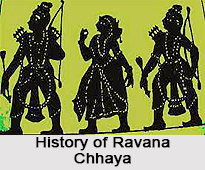 History of Ravana Chhaya is rather interesting to note, and it evidences the influence of different religious forces. Even though the theme of the play is completely based on the stories and legends of Lord Rama, it is named after Ravana. Ravana Chhaya literally means the `shadow of Ravana`. Forms of shadow-theatre surviving in the regions of Andhra Pradesh, Karnataka and Kerala are named respectively, Tholu Bomalatta, Togalu Bombeaatta and Thol Pava Koothu, each literally meaning `dance of leather-dolls`. This manner of naming the form has not been followed in Orissa. The puppet representing Ravana is much larger than that of Rama and also more boldly and dramatically conceived.
History of Ravana Chhaya is rather interesting to note, and it evidences the influence of different religious forces. Even though the theme of the play is completely based on the stories and legends of Lord Rama, it is named after Ravana. Ravana Chhaya literally means the `shadow of Ravana`. Forms of shadow-theatre surviving in the regions of Andhra Pradesh, Karnataka and Kerala are named respectively, Tholu Bomalatta, Togalu Bombeaatta and Thol Pava Koothu, each literally meaning `dance of leather-dolls`. This manner of naming the form has not been followed in Orissa. The puppet representing Ravana is much larger than that of Rama and also more boldly and dramatically conceived.
All this may indicate the influence of Jainism and Buddhism. It is stated in the Jain Harivamsa Parana that Mahavira Vadhamana (599 B.C. to 527 B.C.) preached Jainism in Kalinga. This is also mentioned in Haribhadriya Vritti, another sacred book of the Jains. With the Kalinga invasion of Ashoka in 3rd century B.C. Buddhism came to be dominant, but soon after during the reign of Kharavela (2nd century B.C.) Jainism was revived in Kalinga and it held sway for more than 200 years. From the writings of Taranatha we learn that in the first century A.D. the great Buddhist saint Nagarjuna came to Orissa to preach Sunyavada. He converted the then King Munja to Buddhism and built many Buddhist monasteries in Orissa. After that from about the 9th century, when Shankaracharya came to Orissa, Brahminism claimed dominance. From the 12th century to the 17th century almost all the rulers of Orissa subscribed to Vaishnavism. From the 3rd century B.C. to 9th century A.D. Brahminism was alternately fighting with Buddhism and Jainism for dominance in this region.
The Jain Rama stories do not paint Ravana as a demon-king but as Prati-vasudev. Paumachariya by Yimal Suri is, perhaps, the earliest Jain-Ramayana. According to Jain tradition it was written in 72 A.D., but considering it from the language point of view some scholars date it to the 4th century A.D. In this work Ravana is killed not by Rama but Lakshmana who as a result had to go to hell for his sin. On the other hand Ravana after some births attains the status of an Arhani, i.e. super-saint. This respectful treatment of Ravana is also found in some Buddhist literature like Lankavatarasutra. Dharmakirti (6th century A.D.) paints Ravana as an ideal Buddhist King.
Therefore it is possible that Ravana Chhaya during its formative period came under the influence of Jainism or Buddhism. Such a deduction is further strengthened by the fact that Dharmabhyudaya by Meghaprabhacharya, which is the earliest chhaya nataka to indicate unmistakably the use of shadow-puppets in Jain drama presenting the story of the conversion of a king to the Jain faith. Though the chhaya nataka cannot yet be dated with certainty, it definitely points to the Jain tradition of popularising their faith through the medium of shadow-theatre.
Another explanation, however, is readily offered for naming the form as Ravana Chhaya. Rama is a god. As in Sanskrit so in Oriya the word for God is devata, which is derived from the root `div,` meaning `to shine`. Devata is, therefore, a being that is luminous. A luminous body does not cast its own shadow but when it is present the shadows of other opaque objects are cast. Rama is no minor god but the incarnation of God and therefore, compounding chhaya with Rama to name the form would be philosophically inconsistent The validity of this explanation is strengthened by the fact that the puppeteers, at time, refer to this form as "Rama nataka, the drama on Rama, but when the word Chhaya is compounded it is always Ravana Chhaya.
However, plausibility of the explanation is questioned by the fact that the puppet representing Rama does cast a shadow on the screen in the actuality and the puppet figure is designed in no special way. On the other hand the Ravana figure looms large in comparison with that of Rama. Of course, Ravana has been so characterised in Ramayana as to inspire the imagination of the original puppet designer for a highly stylistic treatment. Nevertheless, Rama should not look insignificant in comparison with Ravana unless there is some special motive for it. Therefore, it would not be far-fetched to assume that Ravana Chhaya initially was influenced by the Jain Ramayana Paumachariya of Vimal Suri.




















